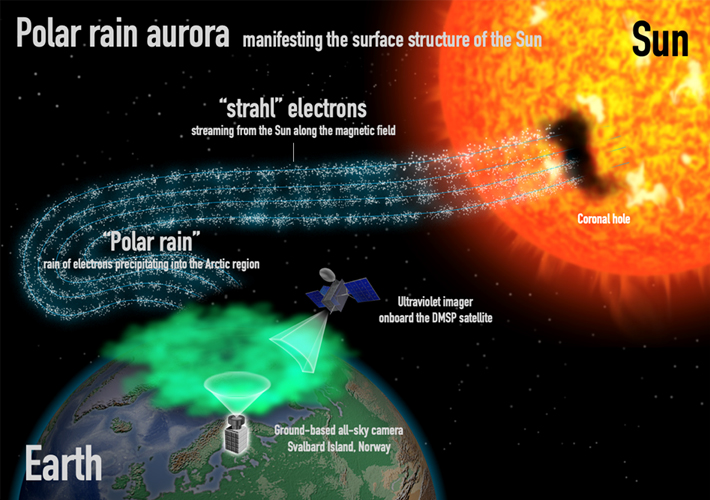Research HighlightsResearch
January 2025 Issue
Space science Gigantic auroras revealed: Unveiling solar dynamics during rare solar wind disappearance
An international research team led by Keisuke Hosokawa and including Takuo Tsuda of the University of Electro-Communications, in collaboration with Kyoto University and the National Institute of Polar Research, has captured a rare and strikingly large aurora spanning the Arctic region. This unprecedented observation occurred during an unusual solar phenomenon where the solar wind, a stream of charged particles that typically interacts with the Earth's magnetosphere to create auroras, almost completely vanished. The study, published in Science Advances provides new insights into how auroras can form in the absence of normal solar wind conditions and reveals unexpected complexity in auroral behavior under these rare circumstances.
The aurora, observed on December 25, 2022, coincided with a day-long disappearance of solar wind—a phenomenon so rare that it has been recorded only a few times in recent history. This event provided a unique opportunity to study aurora formation under unusual space weather conditions. Using a combination of ground-based all-sky aurora cameras located in Svalbard, Norway, and ultraviolet imaging instruments aboard the DMSP satellite, the research team was able to observe and analyze the aurora simultaneously from both space and Earth. The aurora covered the entire Arctic region, producing an extraordinarily bright display visible even to the naked eye from the ground.
The formation of this aurora was found to be caused by a process known as "polar rain", in which electrons from the Sun are funneled directly along magnetic field lines to Earth’s polar regions. Unlike typical auroras, which are driven by interactions between the solar wind and Earth’s magnetosphere, this polar rain aurora occurred when the solar wind had nearly disappeared. This finding reveals a different mechanism for aurora formation, one that involves direct streams of electrons from the sun’s surface, rather than the more commonly observed solar wind interactions.
The research also uncovered intricate patterns within the aurora that had not been previously documented in such detail. High-resolution ground-based imaging revealed wave-like structures and mushroom-shaped formations that moved dynamically across the sky at speeds of around 400 meters per second. These complex patterns are thought to reflect the structure of the Sun’s surface, essentially projecting the solar surface onto the Earth’s polar atmosphere. This discovery suggests that auroras, particularly those created by polar rain, could potentially be used as a new method to study the magnetic and plasma structures on the Sun’s surface remotely from Earth.
The simultaneous observation of this polar rain aurora from both space and the ground marks a first in the field of auroral studies and provides valuable data on how such auroras can form under unique space weather conditions. This research not only expands our understanding of auroral dynamics but also opens up new avenues for studying solar activity and its direct impacts on Earth.
The authors say: “The implications of this work are far-reaching, suggesting that future auroral observations could help map solar surface structures and improve our understanding of the sun-Earth connection, particularly during periods of reduced solar wind activity.”

References


K. Hosokawa, R. Kataoka, T. T. Tsuda, Y. Ogawa, S. Taguchi, Y. Zhang and L. Paxton, Exceptionally gigantic aurora in the polar cap on a day when the solar wind almost disappeared. Sci. Adv. 10, eadn5276 (2024).
- URL : https://www.science.org/doi/10.1126/sciadv.adn5276
- DOI : 10.1126/sciadv.adn5276


